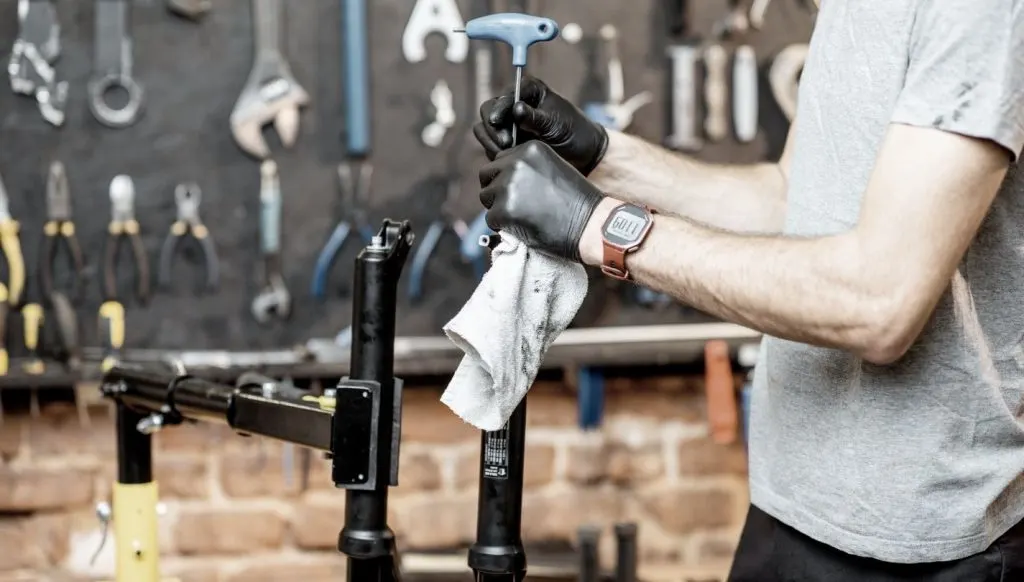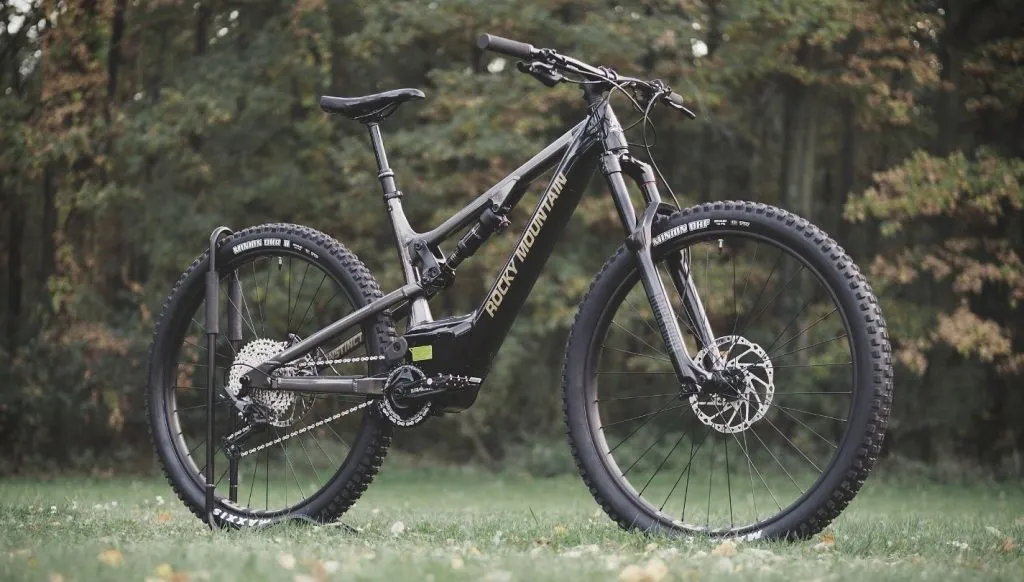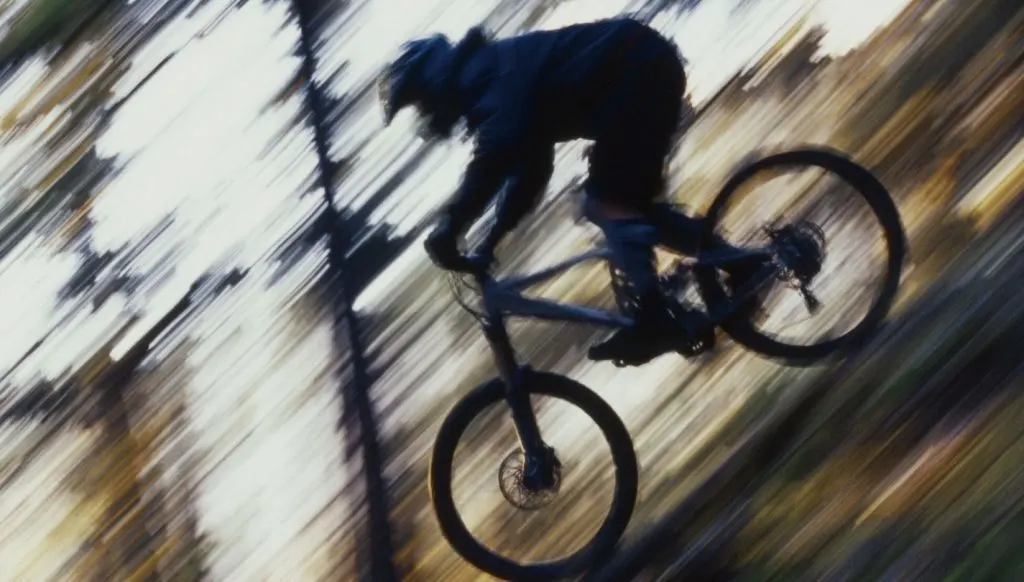
For most of us who ride bikes, upgrading a bike is as much a part of the hobby as actually going for a ride. So I recently wondered if it’s possible to put a bigger fork on my mountain bike, and what I’ve learned is really interesting.
It is possible to put a bigger fork on your bike, but doing so will change the entire geometry of the bike. Typically, ascending steep slopes will be more challenging because your weight is further back. Descending, however, will be easier because of the “slacker geometry.“
It comes down to the old saying: “Just because you CAN do it, doesn’t mean you SHOULD.” That’s not to say that it’s simply a bad idea, quite the contrary, but there are certain limitations.
In this article, I’ll go through why you might want to put a bigger fork on your bike, how it might affect your ride, and the pros and cons of doing it. This will help you decide if it’s the right choice for you or not.
Why Would You Want To Put A Bigger Fork On Your Bike?
So, why would you want to make this change in the first place and what does it mean for your bike?
While it could be a matter of trying something new, the more likely reason is that riding a bike is a progressive hobby. As your skills develop over time, you might find yourself increasingly drawn to a specific riding style.
Perhaps you bought a cross-country bike as your first bike, and now, a few years down the line, you are enjoying the world of enduro more. Unfortunately, buying a new bike isn’t always an option, so you’re left with upgrading your trusty steed to keep up with your needs.
As you start shifting from cross-country type riding toward the more aggressive enduro and downhill side of the spectrum, you see a dramatic increase in fork sizes.
Understand Bike Geometry
Geometry is a term you have probably come across in biking circles and forums. But, if you’re anything like me, you probably got a bit lightheaded when you first saw the word as it brought back stressful memories of math class!
Fear not, it’s nowhere near as complicated, but it is essential to understand if you want to mess around with fork sizes or not. There are 4 parts to bike geometry you need to know about:
#1: Wheelbase
The wheelbase of a bike is pretty much just how far apart the two front and back wheels are. It’s the distance between the center point of the two hubs.
- Longer wheelbases are generally preferred by riding disciplines that are more downhill-orientated.
- Shorter wheelbases are preferred for ascending and technical riding disciplines such as cross country.
#2: Bottom-Bracket Height
Bottom bracket (BB) height is simply how high your BB is off the ground.
- A higher BB will offer better clearance, making it easier to pedal over rock gardens and tree stumps, for example.
- A lower BB will drop the center of gravity of your bike, making the bicycle generally handle better.
#3: Handlebar Height
As the name suggests, handlebar height is pretty much the height of your handlebars. It doesn’t mean all that much as an independent measurement, but it becomes a huge deal if you consider its relation to your seat height.
The height of your handlebars plays a massive role in how your weight is distributed on your bike.
- Lowering your handlebars will shift your weight over the front wheel, helping you climb better.
- Higher handlebars shift your weight further back, which generally helps with descending (up to a point).
With your weight too far forward, it feels like you will go a-tumbling down. Too far back, your front wheel will struggle to find grip in a corner, sending you to the ground.
#4: Head And Seat Tube Angle
Head angle is a term you’ve more than likely come across many times, and it might even be part of your motivation for wanting to increase your fork size. The head angle is the angle of your fork with a flat plain to the rear hub.
- The smaller the angle is, the slacker the bike’s geometry because the front wheel is “further” forward.
- The bigger the angle, the steeper the geometry is, and a steep geometry puts the front wheel closer to you.
Seat tube angle is simply the angle of the seat tube with the ground or a horizontal line.
- A smaller angle puts the seat further back
- A more significant angle puts it closer to the handlebar.
How A Bigger Fork Affects Geometry

With that out the way, we can start looking at how a bigger fork may be a good or bad idea, depending on your riding style and needs. Putting a longer fork on your bike will change the entire geometry of the bike. Let’s walk through what will happen.
#1: A Longer Wheelbase And Slacker Head Angle
I’m going to deal with the wheelbase and head angle as a pair because they go hand in hand, and this change is probably the most significant.
Adding length to your fork means that the front wheel will be pushed forward. This forward shift of the front wheel increases the wheelbase while decreasing the head angle.
Doing something extreme like changing a 100mm travel fork to a 180mm will result in changes of up to 6 degrees in head angle and 150 – 180mm in wheelbase. If you don’t know what that means, those are some significant changes.
Okay, so you may not want to go as far as that, but the bike will be slacker with a longer fork.
At the same time, your seat angle will also be smaller, meaning that your seat is going to move further “back.” This one might be a little hard to get your mind around because when I say “further back,” I don’t mean further away from the handlebars.
Think of it as leaning back in your chair. The angle of the seat changes, and the angle at which you sit with the ground changes.
#2: A Higher Bottom Bracket And Handle Height
You can probably guess what the effect of a longer fork is going to have on your bottom bracket and handlebar height: both are going to go up.
So, you will be left with a handlebar that is higher off the ground. Combined with the smaller seat angle, you can be left with a slightly weirder geometry than you are used to.
Ideally, you want your seat to be level with your handlebars. Or even higher if you are hardcore into cross country. A seat and handlebar that’s level will give you a balanced ride. Add a dropper post to get the seat out of the way, and you’re good to ride down just about anything.
(A dropper post is a seat post that you can adjust without getting off your bike; here’s an example of one on Amazon)
Handlebars that are higher than the seat are not ideal. It’s okay for a town cruiser look, but it will be a challenge to pedal up a steep hill.
Your bottom bracket is also going to be pushed higher off the ground. As I said, this is great for clearance but does change the center of gravity and handling.
Final Verdict: What Is The Effect Of A Bigger Fork on your Bike?
Changing your fork out for a bigger one may absolutely work for you or completely ruin your ride, depending on what you hope to achieve. There are pros and cons to such drastic changes to geometry. Here’s what you need to think about…
The Uphill Challenge Of A Bigger Fork
Let’s get this out the way first: it’s highly likely that your bike just isn’t going to climb as well as it used to. The slacker geometry means that the front wheel is further forward than it used to be, and weighing it down will be difficult.
Before you think that it’s just a matter of leaning further forward, remember that your handlebar is also higher. So despite how far you lean, you just aren’t going to get the same weight on that front wheel.
If you’re making a giant change to the fork size, you may find that to prevent that front wheel from popping up, you have to lean so far forward that you completely lose grip on the rear.
Couple the higher handlebar with the seemingly lower seat, and you really don’t have a bike that wants to climb a technical ascent with ease.
The longer wheelbase will be especially challenging on climbs with tight switchbacks. Slow-speed sharp turns and long bikes directly oppose one another, so don’t expect to be the cream of the cross-country crop.
Granted, with some practice, you will get used to the bike’s handling, and to an extent, you can master most of the limitations and challenges. Just be aware that there will be a learning curve and that your once loved bike may frustrate you on those tricky ascents.
On the plus side, it’ll be easy to get your front wheel up and over obstacles. Bringing it back down is another matter, however.
The Downhill Rodeo Of A Bigger Fork

Hold on and go. That’ll probably be your new riding motto with that slacker bike.
Slack bikes really shine on steep descents. The backward shift of your center of gravity coupled with the “grounded” feel of the longer wheelbase just oozes confidence, especially on trickier bits.
Not only is the geometry really going to help you go downhill, but the added suspension may make a difference as well.
The higher BB means that you can roll over more giant rocks and stumps with less fear of scraping your bike. In addition, the slacker seat angle places your weight exactly where you need it.
However, keep in mind that even on downhills, there are times, like going around a sharp corner, when you need your front wheel to grip. Grip comes from tires and weight, and it’s going to take some practice for you to get used to where to position your body to weigh down the front wheel.
Another factor to consider is that the added confidence and slacker geometry means that you are almost definitely going to go faster.
That added speed is good unless you don’t have the correct breaks to slow you down. So, I would suggest that if you spend the money to invest in a bigger fork, then save up for better breaks as well.
There’s little use in being able to double your speed but not having the breaks to slow you down. In fact, it’s a recipe for a hospital visit.
Is A Bigger Fork Worth It?
As you have likely concluded, there’s a lot of subjectivity regarding whether or not a bigger fork is worth it.
If you’re happy with the sacrifice to your uphill game to gain those seconds on the descent, then it may absolutely be worth it. However, there is one last consideration to keep in mind.
Do your research very well. Sometimes the smallest and biggest changes are the least desirable. For example, I’ve mentioned earlier how drastic the jump from a 100mm to 180mm fork is on the bike’s geometry. The change is so significant that you may hate the bike after it.
On the complete opposite side of the spectrum, some changes are too small. There are numerous stories online where people have added 10mm to their forks, and the added suspension is unnoticeable, while the shift in the geometry is detrimental.
The best thing would be to aim for a substantial but not ridiculous increase. And then do your research in that realm to see if others were happy with it or not. Always research before you buy.
Here is a fantastic video by GMBN on the topic of bigger forks to help you along:
Conclusion
It is possible to swap out your current fork for a bigger and longer one. However, that doesn’t mean it is absolutely the best idea.
A longer fork will change your bike’s entire geometry by making it slacker and higher. Your handlebars will be lifted, and your seat will be further back.
The change will make steep, technical climbs difficult because you will struggle to keep enough weight on the front wheel.
However, it also makes going downhill easier and, dare I say, more fun. Just keep in mind that added speed downhill will require better breaks to get you to a stop.
You might also be interested in:
